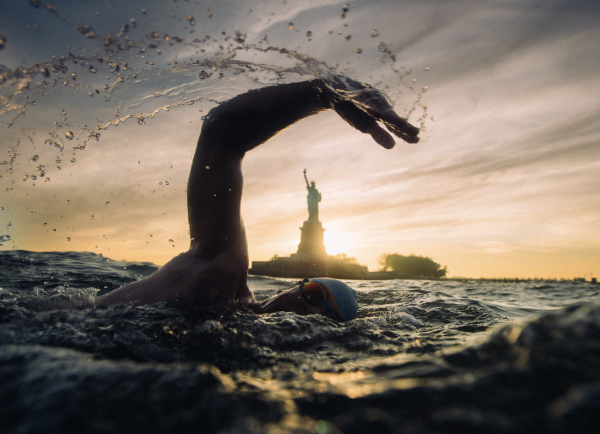KID REPORTERS’ NOTEBOOK
Swimming for the Environment
Last summer, Lewis Pugh swam the length of the Hudson River to call attention to successful efforts to clean up the river.
Born in England, Lewis Pugh grew up in South Africa. Along the rocky southern coast of Africa, he developed a passion for swimming. Pugh went on to become a maritime lawyer before committing full-time to “environmental justice for our oceans.”
For the past 35 years, Pugh has led swims in all of the world’s oceans. He swims for more than just exercise. Pugh is drawing attention to the effects of climate change and the urgent need for action. In 2020, for example, he swam beneath the frigid Antarctic ice sheet to underscore the danger of melting polar ice caps. In 2022, he became the first person to swim across the Red Sea in the Middle East. Pugh’s trek served to remind policy leaders of the harm human activity is causing coral reefs.
In 2013, Pugh was named the first United Nations Environment Programme (UNEP) Patron of the Oceans. The role was created to enhance advocacy for the oceans in global political discussions, the media, and beyond.

After working as a maritime lawyer, Pugh has turned his full attention to environmental justice.
REVERSING A RIVER’S DECLINE
Last summer, Pugh demonstrated the positive impact that humans can have in combatting environmental pollution. Starting high in New York’s Adirondack Mountains, he swam the length of the Hudson River, a total of 315 miles.
Pugh was the first person to swim the river’s entire length without fins, a wetsuit, or any other assistance. He wanted to spotlight the cleanup of the river. For decades, it had been polluted, mostly by toxic chemicals from local industries. Then local government agencies, advocates, and corporations worked with the Environmental Protection Agency to decontaminate the river and repopulate it with aquatic plants.
After 32 days in the water, Pugh made it to New York City. He arrived just in time for three big events in September: Climate Week, the UN General Assembly, and the UN Secretary General’s Climate Ambition Summit.
Pugh used the opportunity to press leaders on environmental issues. “Fifty years ago, the Hudson was one of the most polluted rivers in the whole world and a swim like this would have been absolutely impossible,” Pugh told members of the press. “In the 1970s, New Yorkers said, ‘Enough is enough!’ and started cleaning up this river. [They] started mile by mile, and town by town, and one factory after the next. And they turned the fate of this river around, and that of the wildlife that call it home.”
During his journey along the Hudson, Pugh met people who have an interest in keeping the river clean. These include leaders of Indigenous groups, swim and rowing teams from local colleges, and conservationists and outdoor enthusiasts. Pugh also spoke with politicians and business leaders.

Pugh stopped along his Hudson River swim to visit with Mika (center) and her sister Kaya, 9.
CREATING PROTECTED MARINE AREAS
My nine-year-old sister Kaya and I, are both avid swimmers. We joined Pugh for a five-mile stretch near Poughkeepsie, New York. When asked how he felt at the end of his swim, Pugh said, “The body is sore . . . but I feel rejuvenated.”
Pugh hopes that efforts to protect the Hudson River will inspire efforts to clean up other waterways around the world. Through his nonprofit Lewis Pugh Foundation, he is also “urging nations to fully protect 30% of the world’s oceans by 2030.” This could be accomplished, he says, by creating protected areas, like National Parks.
Nearly 70% of the UN’s 193 member countries have already agreed to the goal. Pugh is proud of his success, but he acknowledges that a lot of work remains. He encourages youth activism and applauds even small environmental choices, like carrying a reusable water bottle. Small changes add up, he said, leading to big results.
